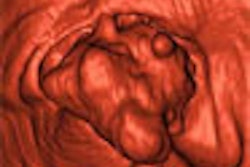Contrast-enhanced ultrasound (CEUS) is more sensitive than three-phase CT in depicting vascularity in hepatocellular carcinomas (HCCs) treated with transcatheter arterial chemoembolization (TACE), according to an article in the April 2006 Journal of Ultrasound in Medicine.
"Contrast-enhanced sonography is a useful imaging method for depicting the tumoral vascularity in HCCs treated with TACE, and can help determine the need for additional treatment," wrote researchers from Asan Medical Center in Seoul, Korea, and Toronto General Hospital in Ontario, Canada.
To compare the two modalities in assessing therapeutic response from TACE, the study team evaluated 29 patients (19 men and 10 women with a mean age of 58 years) with nodular HCCs treated with TACE (JUM, April 2006, Vol. 25:4, pp. 477-486). Two radiologists performed the sonographic exams using the Levovist contrast agent (Schering, Berlin), an Acuson Sequoia scanner (Siemens Medical Solutions, Malvern, PA), and a 1- to 4-MHz curved linear-array probe.
The patients also received three-phase helical CT using either a Somatom Plus-S scanner (Siemens Medical Solutions), a HiSpeed CT/i scanner (GE Healthcare, Chalfont St. Giles, U.K.), or a LightSpeed QX/i scanner (GE Healthcare). Images were obtained with 5- to 8-mm collimation, a table speed of 10-17.5 mm/sec, and reconstruction intervals of 5-7 mm.
The researchers obtained scans before contrast agent injection and during the hepatic arterial and portal venous phases. CEUS and CT findings were prospectively interpreted separately for the presence or absence of contrast enhancement in the treated HCCs, with conventional angiography serving as the reference standard.
Intratumoral enhancement was seen in 19 HCCs (61%) on CEUS, compared with 12 (39%) on CT. On sonography, enhancement patterns were blush in eight (42%), stippled in five (26%), nodular in four (21%), and branching in two (11%).
Of the 19 HCCs with CEUS intratumoral enhancement, 13 (68%) had tumor staining on angiography. One of 12 HCCs without intratumoral enhancement on sonography showed tumor staining on angiography, according to the researchers.
In depicting flow in HCCs treated with TACE, CEUS turned in a sensitivity of 93% and a specificity of 65%. Three-phase CT produced a sensitivity of 64% and a specificity of 100%. The difference in the ability to detect intratumoral blood flow between CEUS and CT was not statistically significant, however.
CEUS offers a number of benefits over three-phase CT, according to the researchers.
"First, contrast-enhanced sonography can visualize serial enhancement patterns of HCCs, and the interpretation is not disturbed by iodized oil," the authors wrote. "Second, contrast-enhanced sonography can be performed immediately after TACE before washout of iodized oil. Third, identification of the location of tumoral flow can help target the lesion during sonographically guided radiofrequency ablation."
However, the authors noted that CEUS is intrinsically operator-dependent, as is conventional sonography, and is under the influence of the sonic window.
"Despite efforts to optimize Doppler parameters, contrast-enhanced sonography has a sonographic artifact," the study team wrote.
By Erik L. Ridley
AuntMinnie.com staff writer
March 31, 2006
Related Reading
Focused exams suitable for some musculoskeletal US studies, March 26, 2006
3D ultrasound shows value in detecting fetal malformations, March 24, 2006
Detection of liver metastases with contrast-enhanced ultrasound, March 23, 2006
Contrast-enhanced US useful for differentiating focal liver lesions, January 19, 2006
Laser ablation of liver metastases proves long-term effectiveness, November 30, 2005
Copyright © 2006 AuntMinnie.com





















